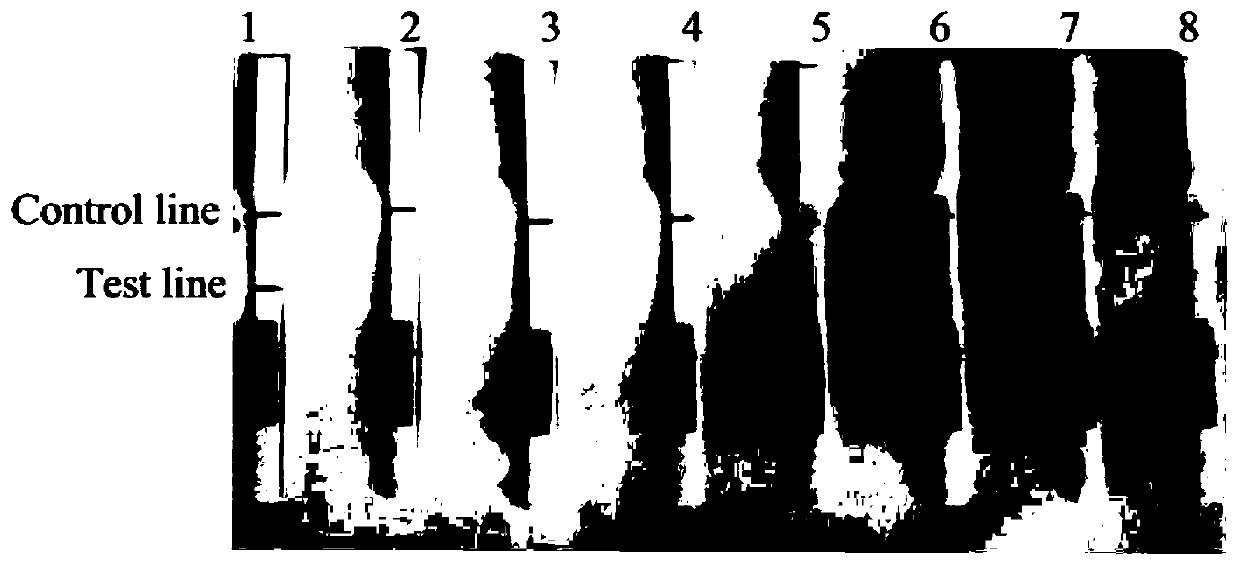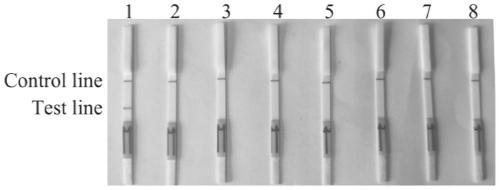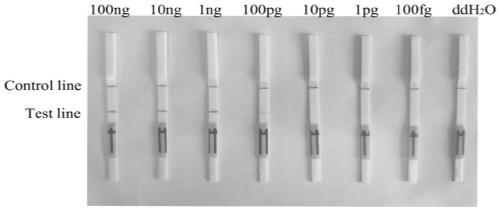A combination of primers and probes for the detection of Phytophthora syringae based on rpa-lateral flow chromatography and its application
A technology of Phytophthora syringae and lateral flow chromatography, which is applied in the biological field, can solve problems such as no relevant application reports, and achieve good amplification effect, increased sensitivity, and good specificity
- Summary
- Abstract
- Description
- Claims
- Application Information
AI Technical Summary
Problems solved by technology
Method used
Image
Examples
Embodiment 1
[0038] The genomic DNA of the tested pathogenic bacteria strain was extracted, and the specific extraction process was as follows:
[0039] Take a small amount of mycelium powder, add 900 μL 2% CTAB extract and 90 μL 10% SDS, vortex and mix well, put in a water bath at 60°C for 1 hour, and invert several times every 10 minutes. Centrifuge at 12000rpm for 10min, take the supernatant and add an equal volume of phenol / chloroform / isoamyl alcohol (25:24:1), mix by inversion, and centrifuge at 12000rpm for 10min; transfer the supernatant to a new tube, add an equal volume of chloroform, Gently invert to mix and centrifuge at 12000rpm for 5min. Take the supernatant and transfer it to a new tube, add 2 times the volume of absolute ethanol and 1 / 10 volume of 3M NaAc (pH5.2), and precipitate at -20°C (>1h). Centrifuge at 12000 rpm for 10 min, pour off the supernatant, wash the precipitate twice with 70% ethanol, and dry at room temperature. Add appropriate amount of sterilized ultrapu...
Embodiment 2
[0041] The length of RPA primers is generally 30 to 35 nucleotides. Too short primers will seriously affect the activity of recombinases. Long primers do not necessarily improve the amplification performance, but instead increase the possibility of forming secondary structures, increasing the noise. In addition, when designing primers, try to avoid sequences that are easy to form secondary structures, primer-primer interactions, and hairpin structures, so as to reduce the formation of primer-dimers, and the size of the amplified product should not exceed 500bp. According to the above-mentioned primer design principle, the present invention uses Primer Premier 5.0 to design forward primer sequence RPA-PsyYPT-F, reverse primer sequence RPA-PsyYPT-R, probe sequence according to the Ypt1 sequence (KJ755159.1) of Phytophthora syringae PsyYPT-P.
[0042] The specific sequence is as follows: the forward primer is RPA-PsyYPT-F: 5'-TCTGCTAGCAGACTGCTGACTGTTCTATCT-3'; the reverse primer...
Embodiment 3
[0046] In order to verify the specificity of the RPA lateral flow chromatography test strip detection method, with 1 strain of Phytophthora syringae and other oomycetes and pathogenic fungi as test materials (Table 1), the RPA lateral flow chromatography test strip detection method The results showed that there were two brown bands on the test strip of Phytophthora syringae, one in the quality control area and one in the detection area, the result was positive, and the test strips of other oomycetes and pathogenic fungi only appeared in the quality control area A brown band with no band in the test area is negative, indicating that Phytophthora syringae is not present in the sample. Select different species of Phytophthora syringae (Phytophthora winter; Phytophthora parasitic; Phytophthora infestans; Phytophthora woody; Phytophthora strawberry; Phytophthora ramie, etc.) Magnaporthe oryzae; Rhizoctonia solani; Verticillium dahliae; Pythium ultima) DNA was used as a template for...
PUM
| Property | Measurement | Unit |
|---|---|---|
| Sensitivity | aaaaa | aaaaa |
Abstract
Description
Claims
Application Information
 Login to View More
Login to View More - R&D
- Intellectual Property
- Life Sciences
- Materials
- Tech Scout
- Unparalleled Data Quality
- Higher Quality Content
- 60% Fewer Hallucinations
Browse by: Latest US Patents, China's latest patents, Technical Efficacy Thesaurus, Application Domain, Technology Topic, Popular Technical Reports.
© 2025 PatSnap. All rights reserved.Legal|Privacy policy|Modern Slavery Act Transparency Statement|Sitemap|About US| Contact US: help@patsnap.com



